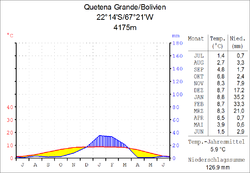Peña Barrosa
| Peña Barrosa | ||
|---|---|---|
 Peña Barrosa (Quetena Chico) with the Uturuncu in the background |
||
| Basic data | ||
| Residents (state) | 686 pop. (2012 census) | |
| height | 4150 m | |
| Post Code | 05-1001-0300-1001 | |
| Telephone code | (+591) | |
| Coordinates | 22 ° 12 ′ S , 67 ° 20 ′ W | |
|
|
||
| politics | ||
| Department | Potosí | |
| province | Sur Lípez Province | |
| climate | ||
 Climate diagram Quetena Grande |
||
Peña Barrosa (also: Peña Barrasa or Quetena Chico ) is a town in the Potosí department in the highlands of the South American Andean state of Bolivia .
Location in the vicinity
Peña Barrosa is the largest town in the canton of Quetena Grande in the district ( Bolivian : Municipio ) of San Pablo de Lípez in the province of Sur Lípez . The village is located at an altitude of 4150 m on the left western bank of the Río Quetena , which flows here in a northerly direction and joins the Río Grande de Lípez about sixty kilometers downstream and continues to the Salar de Uyuni .
geography
Peña Barrosa is located in the southern part of the Bolivian plateau in the Cordillera de Lípez . The region has a distinct daytime climate, with mean temperatures fluctuating more strongly during the day than during the year.
The annual average temperature of the region is around 6 ° C (see climate diagram Quetena Grande), the monthly average temperatures fluctuate only slightly between a good 1 ° C in June / July and just under 9 ° C in December / January. The annual precipitation is very low at 127 mm, from April to October it is less than 5 mm monthly average, only in the southern summer months of January and February there is significant precipitation.
Transport network
Peña Barrosa is 584 km by road southwest of Potosí , the capital of the department of the same name.
From Potosí the trunk road Ruta 5 leads in a south-westerly direction 208 kilometers to Uyuni , from there the Ruta 21 for a further 96 kilometers to Atocha . From Atocha a country road leads in a south-easterly direction along the old railway line 23 kilometers to Escoriani and then leaves the railway line in a south-westerly direction. It reaches Tatasi after thirteen kilometers and San Vicente after another 29 kilometers .
From there, an unpaved but well-developed country road leads in a south-westerly direction, which on its way overcomes a pass height of about 4750 m and after 88 kilometers in a south-westerly direction reaches San Pablo de Lípez and after another fifty kilometers San Antonio de Lípez . From there it is another 63 kilometers with pass heights of 4,900 m to the entrance to the Eduardo Abaroa National Park and fourteen kilometers to Peña Barrosa .
population
The population of the village has increased roughly threefold in the past two decades:
| year | Residents | source |
|---|---|---|
| 1992 | 231 | census |
| 2001 | 373 | census |
| 2012 | 686 | census |
Due to the historical population distribution, the region has a high proportion of Quechua population, in the municipality of San Pablo 80.9 percent of the population speak the Quechua language.
Individual evidence
- ^ INE - Instituto Nacional de Estadística Bolivia 1992
- ^ INE - Instituto Nacional de Estadística Bolivia 2001
- ↑ INE - Instituto Nacional de Estadística Bolivia 2012 ( Memento of the original from July 22, 2011 in the Internet Archive ) Info: The archive link has been inserted automatically and has not yet been checked. Please check the original and archive link according to the instructions and then remove this notice.
- ↑ INE social data 2001 (PDF; 5.5 MB)
Web links
- Map of the Eduardo Abaroa Protected Area
- Relief map of the Cerro Zapaleri region 1: 250,000 (PDF; 1.30 MB)
- Municipio San Pablo - General Maps No. 51001
- Municipio San Pablo - detailed map and population data (PDF; 1.55 MB) ( Spanish )
- Department Potosí - social data of the municipalities (PDF; 5.23 MB) ( Spanish )
